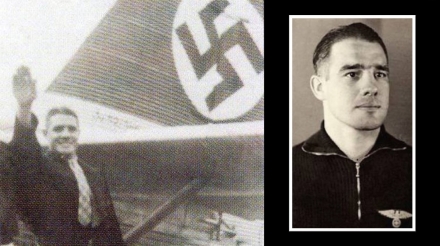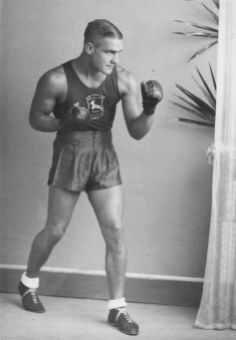Photos: WW2: Hitler & the Boer NAZI: Robey Leibbrandt – Germany’s plan for South Africa
Afrikaanse Boeke op AfricanCrisis
Hier is ‘n paar boeke wat jy nie in gewone liberale winkels sal kry nie!

“It’s not treason if you win”
Lisa Shearin in ‘Bewitched and Betrayed’ said “It’s not treason if you win” and this rings very true to South African traitors from the past and now the present. How history repeating itself in South Africa can be ironic at the best of times, the country’s ethnic diversity will always ensure that one community’s freedom fighter is another community’s terrorist.
This was as true of the Afrikaner Nationalists during the Second World War, as much as it was true to the African Nationalists during the political and armed “struggle” in the more recent past. Both produced “traitors”, both had leaders incarcerated, both went on to ultimately govern South Africa and both produced Presidents who were themselves imprisoned as “traitors to the state”. Ironically – both went on to pardon their fellow activists and make heroes of them. The issue of ‘treachery’ set aside by the ‘winner’.
Robey Leibbrandt
This is the story of one such South African national – Sidney Robey Leibbrandt, who was led by the German military intelligence (Abwehr) during the Second World War under the pseudonym “Robert Leibbrand”.
Born in Potchefstroom Liebbrandt was a Afrikaner Nationalist of both German and Irish decent. He was also a South African Olympic boxer, however his political ideology drove him to become a German secret agent and “freedom fighter” – primarily against the British influence and political power within South Africa.
Leibbrandt went to Germany in 1938 to study at the Reich Academy for Gymnastics, and stayed on when war broke out. He joined the German Army, where he became the first South African to be trained as a Fallschirmjäger and glider pilot. Later a small number of other South Africans also joined the Wehrmacht. Leibbrand was trained with the Comrades of the Brandenburgers at a sabotage training course of Abwehr II (Abwehrschool “Quenzgut”) near Brandenburg an der Havel, west of Berlin.
Operation Weissdorn

Admiral Wilhelm Canaris
The German Admiral Wilhelm Canaris ordered “Operation Weissdorn” a plan for a coup d’état to overthrow the South African government of General Jan Smuts and assassinate Smuts. Central to the plan was Leibbrandt, who left Germany on 5 April 1941 to lead and execute it.
In June 1941, under the code name Walter Kempf, Leibbrandt was dropped on the Namaqualand coast north of Cape Town (Mitchell’s Bay) by a confiscated French sailboat (the Kyloe) His mission was to make contact with the South African pro-Nazi movement, the Ossewabrandwag, and expand his ranks of “freedom fighters”.
In the 1930’s the chief vehicle of Afrikaner nationalism was the “Purified National Party” of D. F. Malan, (which went on to become the National Party as we know it today) and in 1938 the National Party celebrated the centennial anniversary of the Great Trek – the Ossewabrandwag was established in commemoration of the Trek, it was led by Dr Johannes Van Rensburg who was a lawyer and also a dedicated admirer of Nazi Germany.
Afrikaner Nationalist Resistance
The role of the Ossewabrandwag (OB) evolved to become a militant one – the nationalist members were unsympathetic to Britain because of the Boer War and became increasingly hostile when South Africa declared war on Germany in 1939. As sympathizers with Nazi Germany they felt their only solution was armed struggle.
Within the ranks of the Ossewabrandwag was a formation of Stormjaers (Assault troops). The nature of the Stormjaers was evidenced by the oath sworn by new recruits: “If I retreat, kill me. If I die, avenge me. If I advance, follow me”
The Stormjaers engaged in sabotage against the South African government. They dynamited electrical power lines and railroads, and cut telegraph and telephone lines (These types of acts were going too far for most Afrikaners and Malan later ordered the National Party to break with the Ossewabranwag in 1942)
 Robey Leibbrandt, on landing in Mitchell’s Bay hoped to tap into this large resource of Afrikaner ‘Stormjaers’ in his plan to assassinate Smuts and overthrow the government. He made his way to Cape Town to meet and make arrangements with Dr van Rensburg. However, rather disappointingly he found van Rensburg unsympathetic to his plan.
Robey Leibbrandt, on landing in Mitchell’s Bay hoped to tap into this large resource of Afrikaner ‘Stormjaers’ in his plan to assassinate Smuts and overthrow the government. He made his way to Cape Town to meet and make arrangements with Dr van Rensburg. However, rather disappointingly he found van Rensburg unsympathetic to his plan.
Undeterred Leibbrandt continued in his attempts to drum up support from the Afrikaaner Nationalists winning converts from the Ossewabrandwag and the national party to support his cause with fiery speeches at meetings held in the Orange Free State and in the Transvaal. These converts took a Nazi style Blood Oath, and trained in bomb making and sabotage.
Leibbrandt was fully determined in his plot to overthrow the government by force of arms and assassinate Jan Smuts, he famously said the following before leaving for South Africa.
“The signal for the coup d’ etat will shake South Africa to its very foundations. The whole world will understand it. The gigantic leading figure of General Smuts will be felled like a heavy oak tree at the psychological moment. I will commit this deed on my own. It will happen without help or support.” Sydney Robey Leibbrandt (Berlin, March 20, 1941)
Capture
Leibbrandt’s small group of resistance fighters kept the South African government on high alert by committing various sabotage acts. After a confrontation and gunfight with soldiers in the autumn of 1942, Leibbrandt went on the run and evaded the police until he was betrayed by fellow nationalists and arrested in Pretoria in December 1942. (ironically the arresting officer was Claude Sterley, a fellow Springbok boxer and friend).
To get on top of all the wartime dissent and armed resistance from the nationalists, the South African government also cracked down very heavily on the Ossewabrandwag and the Stormjaers, placing thousands of them in internment camps for the duration of the war. Among the internees was future Prime Minister B. J. Vorster, who was a regional leader of the Ossewabrandwag.

Jan Smuts
On 11 March 1943 Leibbrandt was sentenced to death for high treason. Although Leibbrandt refused to give evidence at any stage in the trial, he claimed that he had acted “for Volk and Führer” and gave the German Salute (Hitler Salute) when he first entered the court, to which several spectators responded and calling “Sieg Heil”. After being sentenced to death, Leibbrandt shouted loudly and clearly “I greet death”.
General Jan Smuts however later commuted his sentence to life imprisonment, confiding that he did not want another Jopie Fourie on his hands. In this respect Smuts, as an Afrikaner throughout his career usually bowed to a policy of appeasement politics when it came to Afrikaner issues and his ‘Volk’.
This can clearly be seen in the treatment of both ‘traitors’ and enemies of the state – Smuts took a heavy hand to executing the ring leaders of the Rand Revolt who were mainly ‘English’ Communists, but when it came to the Boer Revolt everyone involved was freed, except Jopie Fourie (who had not resigned from the Union Defence Force as an officer when becoming a rebel and therefore had a different case of treason and was court marshalled by the military instead – whereas all the other rebels had resigned). Smuts took the same relatively ‘light handed’ approach to the Ossewabrandwag and clear cases of sedition and treason as was the case with Leibbrandt and chose not to execute them.
It’s not treason if you win
When the National Party was elected to rule in South Africa in 1948, D. F. Malan issued an amnesty over all their fellow “war offenders,” including the likes of Liebbrandt and the future President BJ Vorster. The National Party then folded the Ossewabrandwag and absorbed their members and structures into the party.
Leibbrandt left the prison and was greeted by crowds of Afrikaner right-wingers and Nationalists as a “folk hero”. The returning servicemen from World War felt it a slap in the face, a blatant political statement as to how much the Afrikaner Nationalists disregarded those who had gone to war against Nazism. To them it was an affront to the sacrifice and loss of thousands of their compatriot South Africans in the war.

Leibbrandt remained politically active in his later life, founding the organisation Anti-Kommunistiese Beskermingsfront (Anti-Communist Protection Front) in 1962, and producing a series of pamphlets titled Ontwaak Suid-Afrika (Wake up South Africa). He was also a passionate sportsman and hunter. Robey Leibbrandt, “Der treue Gefolgsmann” (the loyal follower) died on 1 August 1966 from a heart attack.
The irony is that once in power the rise of African Nationalism (ANC) and their decision to embark on armed resistance mirrors that of the Afrikaner Nationalism. Like the armed wing of the Afrikaner Nationalists – the Ossewabrandwag ‘terrorists’ and ‘traitors’ were imprisoned as enemies of the state, so too were the armed wing of the ANC – Umkhonto we Sizwe. Once in power the Afrikaner Nationalists – the NP – behaved no different to the ANC – they built heroes and legacies around their military ‘heroes’, issued pardons and amnesties – and also renamed streets and institutions after them.
In Conclusion
But most ironic is that from the ranks of imprisoned ANC leaders emerged Nelson Mandela, and from the ranks of imprisoned National Party members emerged BJ Vorster – both of whom went on to become President. Strange how history turns and repeats itself.
Both entirely different now, history now looks favourably on Mandela and the African Nationalists (ANC) and its cabal and dismisses their acts of treason in light of a ‘honourable cause’ (liberation from oppression) and history now views Vorster, the Afrikaner Nationalists (NP) and their cabal, like Robey Liebrand and their various acts of treason very unfavourably and point to a ‘dishonourable cause’ (suppression of liberation by oppression).
This brings another famous quote on what qualifies and defines treason, it’s from T.S. Elliot and is very applicable and rings true to the above statement;
“The last temptation is the greatest treason: to do the right deed for the wrong reason”.
Source: https://samilhistory.com/2016/06/16/south-africas-nazi-insurgent-robey-leibbrandt/
2002: Why Black People struggle
This is an article I wrote in 2002, which was published on an American website called Etherzone. In this article I‘m diplomatic and I‘ve written it for Liberal Americans.





